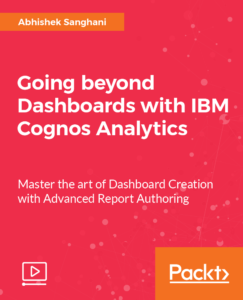Business intelligence occupies a strange position, often overshadowed by fields like data science and machine learning. But it remains a critical aspect of modern business – indeed, the less attention the world appears to pay to it, the more it is becoming embedded in modern businesses. Where analytics and dashboards once felt like a shiny and exciting interruption in our professional lives, today it is merely the norm.
But with business intelligence almost baked into the day to day routines and activities of many individuals, teams, and organizations, what does this actually mean in practice. For as much as we’d like to think that we’re all data-driven now, the reality is that there’s much we can do to use data more effectively. Research confirms that data-driven initiatives often fail – so with that in mind here’s what’s important when it comes to business intelligence in 2019.
Popular business intelligence eBooks and videos

- Oracle Business Intelligence Enterprise Edition 12c – Second Edition
- Microsoft Power BI Quick Start Guide
- Implementing Business Intelligence with SQL Server 2019 [Video]
- Hands-On Business Intelligence with Qlik Sense
- Hands-On Dashboard Development with QlikView
Getting the balance between self-service business intelligence and centralization
Self-service business intelligence is one of the biggest trends to emerge in the last two years. In practice, this means that a diverse range of stakeholders (marketers and product managers for example) have access to analytics tools. They’re no longer purely the preserve of data scientists and analysts.
Self-service BI makes a lot of sense in the context of today’s data rich and data-driven environment. The best way to empower team members to actually use data is to remove any bottlenecks (like a centralized data team) and allow them to go directly to the data and tools they need to make decisions. In essence, self-service business intelligence solutions are a step towards the democratization of data.
However, while the notion of democratizing data sounds like a noble cause, the reality is a little more complex. There are a number of different issues that make self-service BI a challenging thing to get right. One of the biggest pain points, for example, are the skill gaps of teams using these tools. Although self-service BI should make using data easy for team members, even the most user-friendly dashboards need a level of data literacy to be useful.
Read next: What are the limits of self-service BI?
Many analytics products are being developed with this problem in mind. But it’s still hard to get around – you don’t, after all, want to sacrifice the richness of data for simplicity and accessibility.
Another problem is the messiness of data itself – and this ultimately points to one of the paradoxes of self-service BI. You need strong alignment – centralization even – if you’re to ensure true democratization.
The answer to all this isn’t to get tied up in decentralization or centralization. Instead, what’s important is striking a balance between the two. Decentralization needs centralization – there needs to be strong governance and clarity over what data exists, how it’s used, how it’s accessed – someone needs to be accountable for that for decentralized, self-service BI to actually work.
Read next: How Qlik Sense is driving self-service Business Intelligence
Self-service business intelligence: recommended viewing

Data storytelling that makes an impact
Data storytelling is a phrase that’s used too much without real consideration as to what it means or how it can be done. Indeed, all too often it’s used to refer to stylish graphs and visualizations.
And yes, stylish graphs and data visualizations are part of data storytelling, but you can’t just expect some nice graphics to communicate in depth data insights to your colleagues and senior management.
To do data storytelling well, you need to establish a clear sense of objectives and goals. By that I’m not referring only to your goals, but also those of the people around you. It goes without saying that data and insight needs context, but what that context should be, exactly, is often the hard part – objectives and aims are perhaps the straightforward way of establishing that context and ensuring your insights are able to establish the scope of a problem and propose a way forward.
Data storytelling can only really make an impact if you are able to strike a balance between centralization and self-service. Stakeholders that use self-service need confidence that everything they need is both available and accurate – this can only really be ensured by a centralized team of data scientists, architects, and analysts.
Data storytelling: recommend viewing

The impact of cloud
It’s impossible to properly appreciate the extent to which cloud is changing the data landscape. Not only is it easier than ever to store and process data, it’s also easy to do different things with it. This means that it’s now possible to do machine learning, or artificial intelligence projects with relative ease (the word relative being important, of course).
For business intelligence, this means there needs to be a clear strategy that joins together every piece of the puzzle, from data collection to analysis. This means there needs to be buy-in and input from stakeholders before a solution is purchased – or built – and then the solution needs to be developed with every individual use case properly understood and supported.
Indeed, this requires a combination of business acumen, soft skills, and technical expertise. A large amount of this will rest on the shoulders of an organization’s technical leadership team, but it’s also worth pointing out that those in other departments still have a part to play. If stakeholders are unable to present a clear vision of what their needs and goals are it’s highly likely that the advantages of cloud will pass them by when it comes to business intelligence.
Cloud and business intelligence: recommended viewing

Business intelligence ethics
Ethics has become a huge issue for organizations over the last couple of years. With the Cambridge Analytica scandal placing the spotlight on how companies use customer data, and GDPR forcing organizations to take a new approach to (European) user data, it’s undoubtedly the case that ethical considerations have added a new dimension to business intelligence.
But what does this actually mean in practice?
Ethics manifests itself in numerous ways in business intelligence. Perhaps the most obvious is data collection – do you have the right to use someone’s data in a certain way? Sometimes the law will make it clear. But other times it will require individuals to exercise judgment and be sensitive to the issues that could arise.
But there are other ways in which individuals and organizations need to think about ethics. Being data-driven is great, especially if you can approach insight in a way that is actionable and proactive. But at the same time it’s vital that business intelligence isn’t just seen as a replacement for human intelligence. Indeed, this is true not just in an ethical sense, but also in terms of sound strategic thinking. Business intelligence without human insight and judgment is really just the opposite of intelligence.
Conclusion: business intelligence needs organizational alignment and buy-in
There are many issues that have been slowly emerging in the business intelligence world for the last half a decade. This might make things feel confusing, but in actual fact it underlines the very nature of the challenges organizations, leadership teams, and engineers face when it comes to business intelligence.
Essentially, doing business intelligence well requires you – and those around you – to tie all these different elements. It’s certainly not straightforward, but with focus and a clarity of thought, it’s possible to build a really effective BI program that can fulfil organizational needs well into the future.










![How to create sales analysis app in Qlik Sense using DAR method [Tutorial] Financial and Technical Data Analysis Graph Showing Search Findings](https://hub.packtpub.com/wp-content/uploads/2018/08/iStock-877278574-218x150.jpg)





